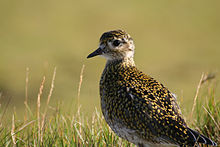European golden plover
| European Golden Plover | |
|---|---|

| |
| Adult in breeding plumage | |
| Scientific classification | |
| Kingdom: | |
| Phylum: | |
| Class: | |
| Order: | |
| Family: | |
| Genus: | |
| Species: | P. apricaria
|
| Binomial name | |
| Pluvialis apricaria (Linnaeus, 1758)
| |
The European Golden Plover (Pluvialis apricaria), also known as the Eurasian Golden Plover or just the Golden Plover within Europe, is a largish plover. This species is similar to two other golden plovers. American Golden Plover, Pluvialis dominiica, and Pacific Golden Plover, Pluvialis fulva, are both smaller, slimmer and relatively longer-legged than European Golden Plover, and both have grey rather than white axillary feathers (only properly visible in flight).
Protection
The European Golden Plover is one of the species to which the Agreement on the Conservation of African-Eurasian Migratory Waterbirds (AEWA) applies.
Origin to the Guinness Worlds Records
On 10 November 1951, Sir Hugh Beaver, then the managing director of the Guinness Breweries,[2] went on a shooting party in the North Slob, by the River Slaney in County Wexford, Ireland. After missing a shot at a Eurasian Golden Plover, he became involved in an argument over which was the fastest game bird in Europe, the golden plover or the red grouse (the former being correct).[3] That evening at Castlebridge House, he realised that it was impossible to confirm in reference books whether or not the golden plover was Europe's fastest game bird.[4][5] Beaver knew that there must be numerous other questions debated nightly in pubs throughout Ireland, but there was no book in the world with which to settle arguments about records. He realised then that a book supplying the answers to this sort of question might prove popular.[6] Later, he published the first Guinness World Records.

References
- ^ Template:IUCN
- ^ "The History of the Book". Guinness Record Book Collecting. Retrieved 2012-02-10.
- ^ Fionn Davenport (2010). Ireland. Lonely Planet. p. 193. ISBN 9781742203508.
- ^ "Early history of Guinness World Records". 2005. p. 2.[dead link]
- ^ Cavendish, Richard (August 2005). "Publication of the Guinness Book of Records: 27 August 1955". History Today. 55.
- ^ Guinness World Records 2005. Guinness; 50th Anniversary edition. 2004. p. 6. ISBN 1892051222.
- Tomek, T. & Bocheński, Z. (2005). Weichselian and Holocene bird remains from Komarowa Cave, Central Poland. Acta Zoologica Cracoviensia, 48A(1-2), 43-65. PDF fulltext

